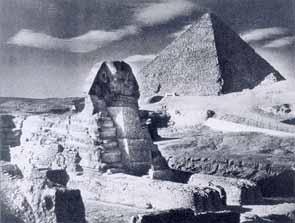|
Giza
Age of the Sphinx
PAGE 1
|
Naturally
geologists have long taken an interest in the Sphinx and the
Giza Plateau as a whole, and the basic geology of the situation
is well established. Dr. K. L.Gauri of the University of Louisville
in Kentucky worked out the sequence of rock members in the Sphinx
and its enclosure in the mid-1980s, alongside the archaeological
investigations of Dr Mark Lehner and Dr Zahi Hawass.
Three rock members are represented at the monument. There
is a bottom level of hard but brittle limestone, largely hidden
under the lower cladding of the Sphinx body but partly seen
in the enclosure walls and floor, that was formed millions
of years ago by sedimentation in shoal-water. Above that,
the slightly younger middle member, which accounts for the
bulk of the body of the Sphinx, is composed of seven separate
beds which all have the interesting characteristic of passing
from worse to better quality of rock from bottom to top, though
the overall quality of the middle member is poor -- which
is why the Sphinx gives a general impression of serious erosion
and damage.
Joints in the limestone deposition, running criss-cross in
the locality of the Sphinx, have in the past caused dislodgment
of blocks of the body core and account for the large fissure
at the rear of the monument. The top member of the Sphinx
site turns into a rather pure and hard limestone above the
neck, which makes for the finer preservation of the facial
detail, give or take some wind erosion and the physical damage
inflicted by the pious medieval sheikh. The stone of the head
is not found elsewhere on the Giza Plateau today, probably
because its outcrop was entirely quarried away by the necropolis
builders with the exception of the knoll they wished to carve
into the king's likeness.

The
Sphinx buttressed against war damage in the 1940's.
Photo: E. Sved |
The lower part of this top member is not good rock, and the
neck is badly eroded, very evidently by wind-blown sand.
|
All the levels of rock within the Sphinx and its enclosure
slope up from east to west and at the same time down from
north to south.
The erosion circumstances of the Sphinx today were explored
by the team of Egyptologists and geologists in the 1980s.
The phenomenon of overnight condensation and absorption by
capillary action was noted, with evaporation in the morning
sun that leads to crystallization of salts within the rock's
pores and spalling off of surface flakes as a result of the
expansion of the crystals. It was also noted that condensation
on the bedrock of the Sphinx and its enclosure could take
place beneath a sand cover, leading to a situation in which
the sand might he perfectly dry at the surface but wet through
only a few centimeters beneath, while the rock itself could
be soaked in water at some depth underneath the wet sand.
This circumstance was judged to encourage the migration of
salts from the depths of the bedrock towards the surface.
So both the geological structure and the erosion plight (at
least in modern times) of the Sphinx were understood by geologists
in the later 1980s. Egyptologists such as Dr Lehner concluded
that erosion processes essentially similar to today's could
account for the decay of the Sphinx between the end of the
Old Kingdom and the early centuries of the New Kingdom, when
they judged that the first major restoration of the Sphinx
was undertaken.

The
Sphinx seen from behind, facing east to the sunrise |
A first thought among the alternative thinkers was that the
Nile flooding might have washed around the Sphinx in some
satisfyingly remote epoch, but this idea had to be given up
when it became clear that to erode the monument up to the
neck, floods of twenty metres or more would have been required
over the Nile Valley. To perpetrate erosion on the core blocks
of the mortuary temple of Khafre, up the Giza Plateau, would
have taken floods of thirty metres or so. Even the most hardened
alternative thinkers seem to have balked at that.
|